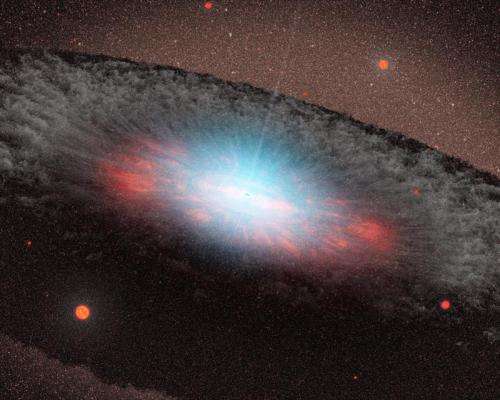Black hole accretion disk observed to 'breathe'

Scientists may have found a link between the pulsations of light coming from a black hole accretion disk and the "breathing" of that disk.
X-ray light coming from accretion disks surrounding black holes often exhibit rhythmic pulses, referred to as quasi-periodic oscillations or QPOs, usually occurring at multiple frequencies. The exact nature of these pulses has been a mystery for over 20 years. Scientists from the College of Charleston, Observatory of Paris, and University of California, Santa Barbara, now may have an explanation for three such QPOs, observed from the X-ray binary, GRO J1655-40.
According to the model, the QPOs are attributed to natural oscillation modes of a hot, inner ring of gas near the black hole. The highest frequency QPO is attributed to the "breathing" motion of this ring. The ring expands and contracts in much the same way that human lungs do whenever a person inhales and exhales. The next highest frequency is associated with "vertical" oscillations of the ring, like a cork bobbing up and down in waves. The lowest frequency comes from the precession of the ring, as its own rotation axis traces out a conical shape in space around the rotation axis of the black hole. This is the same motion that the head of a spinning top or gyroscope traces out.
All gas flows, including black hole accretion disks, have "natural" oscillation modes. These natural modes are generally more easily excited and have larger amplitudes than random fluctuations. "The key is to understand which natural modes are at play in any given system," says lead scientist, Prof. Chris Fragile, of the College of Charleston. In the case of GRO J1655-40, a binary system with a subgiant star in orbit around a 5 or 6 solar mass black hole, the simultaneous observation of three QPOs was critical. By assuming that all three signals were coming from the same part of the accretion disk, the theorists were able to constrain the properties of that part of the disk and isolate which modes could correspond to which oscillation frequencies.
This model may help astronomers better understand black hole accretion and, ultimately, estimate the spin of black holes, an important parameter for interpreting effects related to Einstein's theory of general relativity. "Besides finding a long-sought explanation for the QPO phenomena, this discovery may provide us important details about the exact geometry of black hole accretion flows, which would be helpful in interpreting other observations," says Fragile.
This work has been accepted for publication in the Monthly Notices of the Royal Astronomical Society.
Journal information: Monthly Notices of the Royal Astronomical Society
Provided by College of Charleston





















